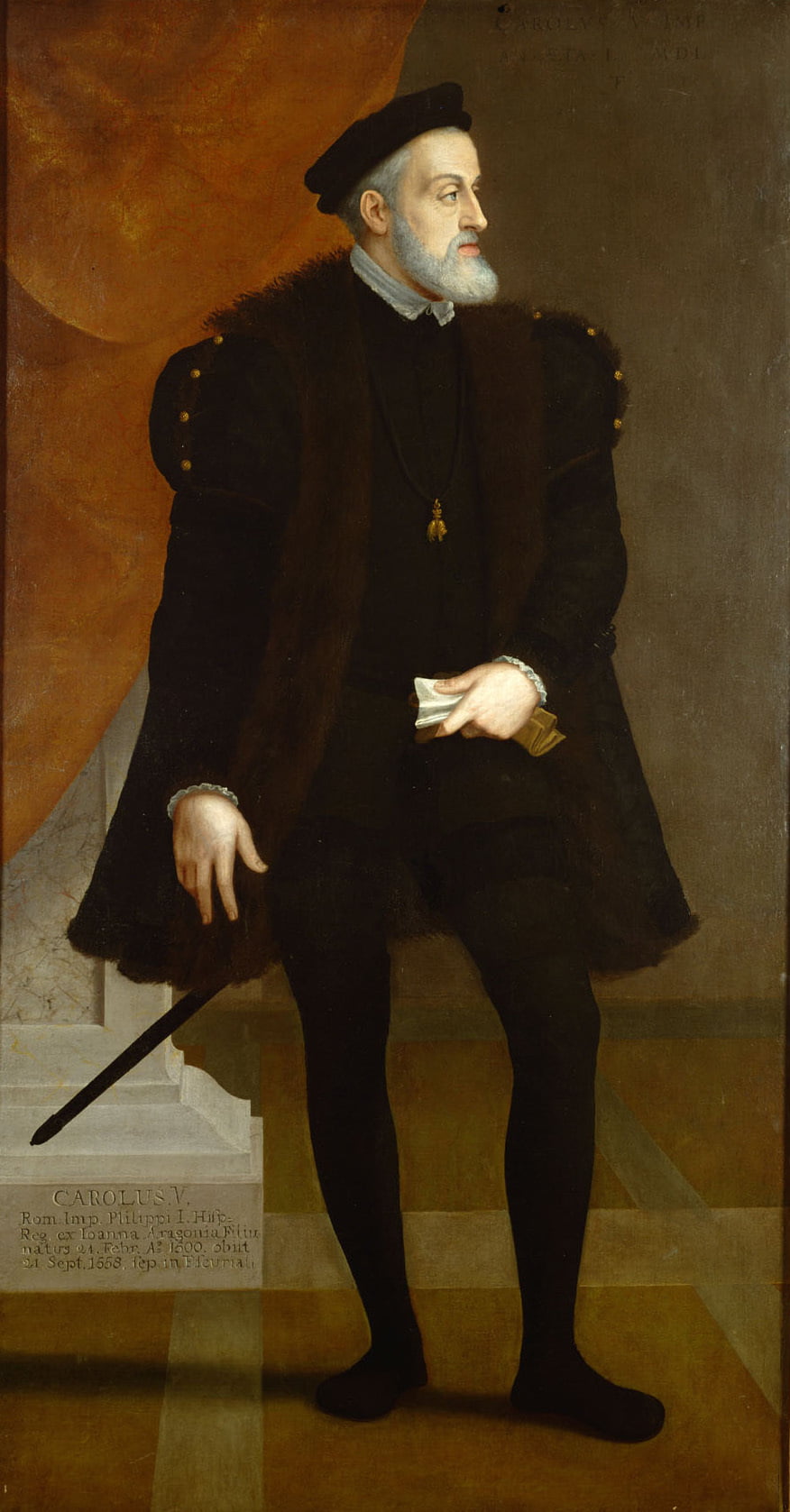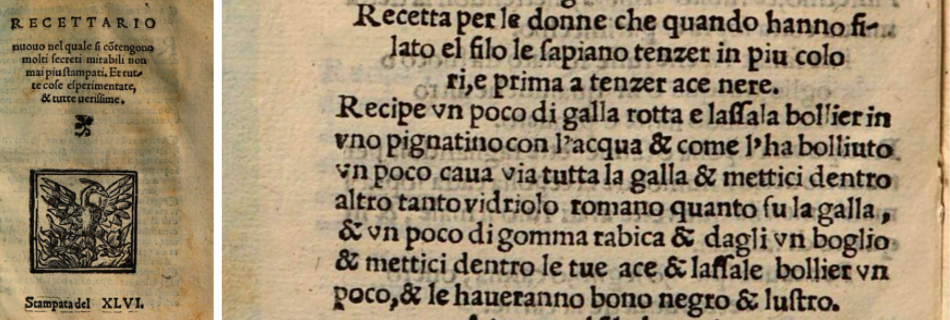When black became the colour of fashion
Visual images suggest that black became the colour of fashion during the late Renaissance period. While powerful men appeared consistently in fifteenth-century portraits in red crimson silks and scarlet woolens, sixteenth-century Europeans, from Italian courtiers to powerful princes and kings, presented themselves uniformly in sumptuous black garments, composed of deep saturated dark over-gowns and black headwear. The black protocol of the Spanish court during the reign of Charles V (1500-1558) and his son Philip II (1527-1598) was especially influential in Europe, because Spain in this period was the most powerful country in the world. The dramatic shift from colorful garments to black clothing is visible not only in official portraiture, but also in contemporary account books that recorded textile purchases.

Francesco Terzio, Portrait of Charles V at the Age of Fifty Years, 1550. Kunsthistorisches Museum, Vienna. ©KHM-Museumsverband
This preference for black in clothing marked a significant chromatic change in European sartorial practice. Although brightly colored clothing in red, green, blue and yellow continued to be worn under black over-gowns and during festivities, carnivals and leisure activities, by the late sixteenth century, black dominated fashion both in portraiture and ceremonial dress all over Europe.
Because of the prestige associated with black, it is usually assumed that black fashion was associated only with powerful princes and high-ranking wealthy European elites. However, documentary sources from Italy demonstrate that that, by the mid-sixteenth century, black was not worn only by rulers, aristocrats and wealthy mercantile classes, but it was by far the most common colour also in the clothing of ordinary artisans and shopkeepers. Post-mortem inventories from Venice, Florence and Siena drawn up between 1550 and 1650, demonstrate that over 40% of all artisans’ clothes that were identified by colour in the inventories were described as black. These included elaborate black woolen over-gowns that were open in the front, called veste and zimarre, worn both by men and women, as well as women’s petticoats, cloaks, small caps and detachable sleeves; and men’s cloaks, cassocks, doublets, hose and felted hats. The majority of black garments were made of wool, including expensive woollens such as say and rash, but many black textile items were also made of silks, including both affordable light and medium-weight silks, such as taffeta, ormesino, tabby and satin, as well as more valuable heavy damasks and grosgrains, and even silk velvets.

Woollen velvet, School of Historical Dress, London. Photo: Refashioning the Renaissance project.
Some of the black garments were made in imitation of their more expensive counter-parts, such as the doublet made of black stamped ‘mocaiardo’, which our Refashioning the Renaissance project is in the process of reconstructing. This upper-garment, made in imitation of doublets of patterned silk velvet, belonged to a Florentine water-seller Francesco Testori who died in 1631. It may have been similar in style to the sleeveless modest black doublet worn by the butcher in Bartolomeo Passerotti image from 1580s.

Bartolomeo Passerotti, Butcher Shop, c. 1580s. Oil on canvas, 112 x 152 cm. Galleria Nazionale d’Arte Antica, Rome.
The high popularity of black was connected, in part, to the symbolic properties of the colour: black was the colour of power. But the importance of black was also bound up with the visual and material qualities of black, because good, intense, fast black was one of the most difficult colours to create.
The best-known method to achieve black in the Renaissance period was to dye the fabric first in dark blue with woad, and then to over-dye the blue fabric in a red madder bath. This method, however, was relatively expensive, both because the dyestuffs were costly and because the preparation of the vat from woad or indigo was a laborious process. A cheaper and less labor-intensive method was to dye black using barks and roots or other vegetal dye sources that contained tannins, such as alder bark, walnuts, chestnuts and oak galls. Combined with vitriol or other iron compounds, tannins gave a beautiful, fast black (Video).
Video shows how adding green vitriol (ferrous sulfate; iron (ii) sulfate) into the dye solution turns the dye bath black.
Printed collections of dye recipes, such as that of Gioanventura Rosetti’s Plichto, published in Venice in 1548, offered advice for dyers to overcome the problems and produce better and cheaper blacks. Rossetti’s manual contained altogether 21 recipes for black, including eight recipes for a “very beautiful black”, most based on a combination of iron salts with tannins from oak galls, sumac or alder bark.
Relatively beautiful blacks could also be produced at home. Simple and less-labor intensive methods for achieving black were circulated in cheap printed media. One of the common recipes for home-dyed ‘lustrous’ black was titled ‘women so that when they have spun yarn they know how to dye it in many colours’. This provided a recipe for making black at home by boiling the fabric in a mixture of oak gall, vitriol, and a small amount of gum arabic.

Opera nvova intitolata dificio de ricette, repeated in another cheap printed collection of recipes titled Recettario nuouo nel quale si co[n]tengono molti secreti mirabili (1546).
Such recipes made it easy and cost-effective for men and women to carry out dye processes within the domestic setting, along with other textile-related recipes, such as stain removal. Although black produced in this way was not necessarily durable, the simple and inexpensive procedure produced a beautiful, uniform colour that could be easily brushed up by repeating the procedure.
These varied and cheaper methods to produce black, based on a range of recipes and dye sources, ensured that black as a fashionable colour became socially wide-spread.
Find out more about black fashion, and the material, cultural, and social significance of black in early modern European clothing in my forthcoming article ‘Power, Black Clothing, and the Chromatic Politics of Textiles in Renaissance Europe’, in Burgundian Blacks, edited by Jenny Boulboullé and Sven Dupré.
Further reading:
Chiara Buss, “A Very Fine Black Color”, in Silk, Gold, Crimson: Secrets and Technology at the Visconti and Sforza Courts, ed. Chiara Buss and Annalisa Zanni (Milan: Silvana Editoriale, 2009)
Elizabeth Currie, Fashion and Masculinity in Renaissance Florence (London: Bloomsbury Academic, 2016)
John Harvey, Men in Black (Chicago: University of Chicago Press, 1995)
Jo Kirby, Maartin Van Bommel and André Verhecken: Natural Colorants for Dyeing and Lake Pigments: Practical Recipes and their Historical Sources (London: Archetype Books, 2014)
Molà, The Silk Industry of Renaissance Venice (Baltimore, London: Johns Hopkins University Press, 2000).
John H. Munro, “The Anti-Red Shift – To the Dark Side: Color Changes in Flemish Luxury Woolens, 1300-1550”, in Robin Netherton and Gale R. Owen-Crocker (eds.), Medieval Clothing and Textiles, vol. 3 (Woodbridge: Boydell Press, 2007), 55-96
Natalia Ortega-Saez, “Black Dyed Wool in North Western Europe, 1680-1850: The Relationship between Historical Recipes and the Current State of Preservation” (unpublished Ph.D. thesis, University of Antwerp, 2018)
Michel Pastoreau, Black: The History of a Colour (New Jersey, Oxfordshire: Princeton University Press, 2008)
Ulinka Rublak, “Renaissance Dress, Cultures of Making, and the Period Eye,” 6-34; Journal of Decorative Arts, Design History, and Material Culture 23, no. 1 (Spring-Summer 2016), pp. 6-34

